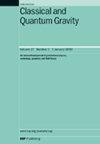Classical-quantum scattering
IF 3.6
3区 物理与天体物理
Q2 ASTRONOMY & ASTROPHYSICS
引用次数: 0
Abstract
We analyze the framework recently proposed by Oppenheim et al (2023 Nat. Commun.14; 2023 Phys. Rev. X13 041040; arXiv:2302.07283 [gr-qc]; 2023 J. High Energy Phys. JHEP08(2023)163) to model relativistic quantum fields coupled to relativistic, classical, stochastic fields (in particular, as a model of quantum matter coupled to ‘classical gravity’). Perhaps surprisingly, we find that we can define and calculate scattering probabilities which are Lorentz-covariant and conserve total probability, at least at tree level. As a concrete example, we analyze scattering of quantum matter mediated by a classical Yukawa field. Mapping this to a gravitational coupling in the non-relativistic limit, and assuming that we can treat large objects as point masses, we find that the simplest possible ‘classical-quantum’ gravity theory constructed this way gives predictions for gravitational scattering which are inconsistent with simple observations of, e.g. spacecraft undergoing slingshot maneuvers. We comment on lessons learned for attempts to couple quantum matter to ‘non-quantum’ gravity, or more generally, for attempts to couple relativistic quantum and classical systems.Classical-quantum散射
我们分析了Oppenheim等人最近提出的框架(2023 Nat. comm .14;2023物理。Rev. X13 041040;arXiv: 2302.07283 (gr-qc);2023 [j] .高能物理。JHEP08(2023)163)来模拟相对论性量子场与相对论性、经典性、随机场的耦合(特别是作为量子物质与“经典引力”耦合的模型)。也许令人惊讶的是,我们发现我们可以定义和计算散射概率,它们是洛伦兹协变的,并且至少在树级上保持总概率。作为一个具体的例子,我们分析了经典汤川场介导的量子物质散射。将此映射到非相对论极限下的引力耦合,并假设我们可以将大型物体视为点质量,我们发现以这种方式构建的最简单的“经典量子”引力理论给出的引力散射预测与简单的观测结果不一致,例如航天器经历弹弓演习。我们评论了尝试将量子物质与“非量子”引力耦合的经验教训,或者更一般地说,尝试将相对论量子与经典系统耦合的经验教训。
本文章由计算机程序翻译,如有差异,请以英文原文为准。
求助全文
约1分钟内获得全文
求助全文
来源期刊

Classical and Quantum Gravity
物理-天文与天体物理
CiteScore
7.00
自引率
8.60%
发文量
301
审稿时长
2-4 weeks
期刊介绍:
Classical and Quantum Gravity is an established journal for physicists, mathematicians and cosmologists in the fields of gravitation and the theory of spacetime. The journal is now the acknowledged world leader in classical relativity and all areas of quantum gravity.
 求助内容:
求助内容: 应助结果提醒方式:
应助结果提醒方式:


